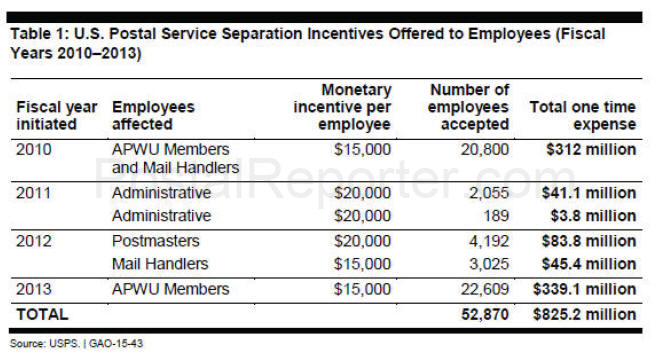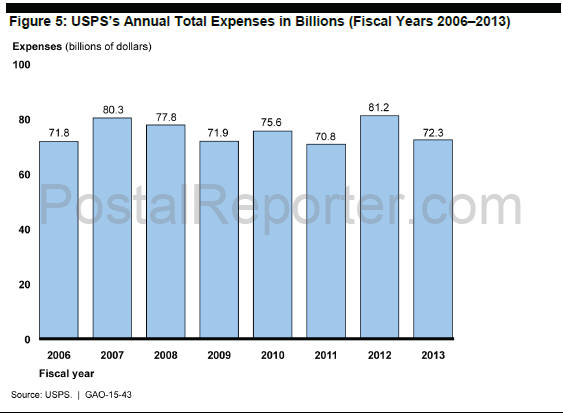 (November 13, 2014) The United States Government Accountability Office (GAO) issued the following report: “U.S. POSTAL SERVICE –Status of Workforce Reductions and Related Planning Efforts.” Report to the Chairman Darrell Issa, Committee on Oversight and Government Reform, House of Representatives
(November 13, 2014) The United States Government Accountability Office (GAO) issued the following report: “U.S. POSTAL SERVICE –Status of Workforce Reductions and Related Planning Efforts.” Report to the Chairman Darrell Issa, Committee on Oversight and Government Reform, House of Representatives
note: Some of the excerpts from report are out of sequence
GAO was asked to examine USPS’s plans to manage the size and cost of its workforce. This report discusses (1) actions USPS has taken since 2006 to reduce the size and cost of its workforce and the results of those actions, (2) the status of other options USPS has identified to reduce workforce costs, and (3) steps that USPS has taken to implement workforce planning. GAO reviewed reports from USPS and the Postal Regulatory Commission on actions USPS has taken to manage the size and cost of its workforce…
GAO interviewed officials or received written responses from APWU, NALC, NPMHU and NRLCA, and two postal management associations including the NAPS and NAPUS to discuss their viewpoints on USPS initiatives, options, and associated challenges. GAO also interviewed representatives from three mailing industry organizations including the Association of Postal Commerce (PostCom), the National Postal Policy Council, and the Parcel Shippers Association to obtain their views on these subjects.
What GAO Found
From fiscal years 2006 through 2013, the U.S. Postal Service (USPS) decreased the size of its workforce and the number of employee work hours through retirements, attrition, and initiatives to streamline its operations. According to USPS’s data, its workforce declined during this period from approximately 796,000 to 618,000 employees, or by about 22 percent. The total number of work hours also decreased by approximately 24 percent, from 1.5-billion hours in fiscal year 2006 to 1.1-billion hours in fiscal year 2013. However, despite the decrease in employees and work hours, USPS’s total expenses over this same time period did not decline. This is because average hourly wage and benefits costs have increased due to (1) cost-of-living allowances, (2) rising health benefit costs, and (3) wage increases negotiated in collective-bargaining agreements. Also, USPS was required to prefund retiree health benefits through 2016, and other non-personnel expenses, such as those for transportation, increased. According to USPS officials, personnel costs will continue to rise and are estimated to be $2 billion more in fiscal year 2015 compared to fiscal year 2014.
PR note: APWU represented employees did not receive any COLAs or wage increases from 2009-2012. For employees represented by other unions in most cases during the years of 2009-2012 the amount of COLA was ZERO. Also as per contract the employee portion of health benefits cost increased.
USPS has considered requiring customers to change to less costly delivery modes and is seeking legislative changes for other initiatives to reduce workforce costs. USPS estimates that mandating large-scale conversions from door delivery to other less costly modes, such as delivery to a curbside or centralized mailbox, has the potential to generate $2 billion in annual savings. However, although USPS has the authority to mandate such conversions, it has not done so because it anticipates that such a change would face resistance from customers, employees, postal labor organizations, and mailing-industry stakeholders. USPS is seeking legislative authorization for several other initiatives that would potentially reduce workforce costs, such as implementing 6-day package and 5-day mail delivery, for an estimated annual savings of $2 billion.
Despite USPS’s reductions in the numbers of employees and work hours from fiscal year 2006 to fiscal year 2013, its total expenses have not decreased over this same time period. As shown in figure 5, total expenses were $71.8 billion in fiscal year 2006 and $72.3 billion in fiscal year 2013.
Although total expenses were similar in fiscal years 2006 and 2013, they ranged from a low of $70.8 billion in fiscal year 2011 to a high of $81.2 billion in fiscal year 2012. These fluctuations were primarily due to changes in payments USPS was required by statute to make in order to prefund retiree health benefits. Specifically, in 2006, the Postal Accountability and Enhancement Act established requirements for USPS to begin prefunding its retiree health benefits and required USPS to make prefunding payments at pre-established amounts ranging from $5.4 billion to $5.8 billion per year, due each fiscal year from 2007 through 2016.
Pub. L. No. 109-435, § 803 121 Stat. 3251 (2006). Before 2007, USPS had funded its retiree health benefit on a pay-as-you-go basis—an approach in which USPS paid its share of premiums for existing retirees, without setting aside funds for current employees. As shown in figure 5 above, total expenses increased in fiscal year 2012 and decreased in fiscal year 2013. This increase was primarily because the payment schedule for prefunding retiree health benefits changed. USPS was required to pay $11.1 billion in fiscal year 2012 and $5.6 billion in fiscal year 2013.
Without including these required prefunding payments, USPS expenses declined by $5.1 billion from fiscal years 2006 to 2013—a 7.1 percent decline. This is a smaller decline than the 24 percent decline in USPS work hours over the same period. According to USPS, three primary reasons explain why total expenses have declined to a lesser extent than work hours. First, the average hourly wage and benefits costs have increased due to factors such as cost-of-living allowances, increased health-benefits costs, and wage increases from collective-bargaining agreements. Second, some other non-personnel related USPS expenses have risen, such as transportation expenses that have increased from $6.0 billion in fiscal year 2006 to $6.7 billion in fiscal year 2013. Finally, many of USPS’s expenses are fixed and, therefore, do not vary with changes in mail volume. However, USPS did not make these retiree health-benefit prefunding payments totaling $16.7 billion because it did not have sufficient cash on hand or borrowing capacity to do so, according to USPS officials.
Looking forward, according to USPS officials, despite taking cost-cutting measures, USPS continues to face rising cost pressures. If there were no change in the workload, number of employees, or composition of the workforce, USPS estimates its personnel costs to be approximately $2 billion higher in fiscal year 2015 compared to fiscal year 2014.
USPS has reduced the size of its workforce largely through retirements and attrition instead of laying off employees. In the context of decreased workload from reduced mail volume, as well as USPS initiatives to streamline its operations, USPS generally has not replaced employees who have left because of retirement or attrition. USPS is prohibited by collective bargaining agreements with labor organizations from laying off certain employees. In addition, according to USPS officials, a sufficient number of employees have separated or retired from the Postal Service, thereby alleviating the need for layoffs. In May 2014, however, USPS announced a planned reduction in force for postmasters who are not covered by collective-bargaining agreements; this reduction in force would take effect in January 2015 as part of the POStPlan initiative, which we discuss later in this report.
To encourage retirements among certain classes of employees, USPS has offered voluntary separation incentives at various times from fiscal year 2010 to fiscal year 2013 (see table 1). During this period, approximately 122,000 USPS career employees retired, with almost 53,000 taking advantage of a separation incentive. The monetary incentives require upfront costs for USPS; however, they result in long-term savings from fewer employees receiving wages and benefits.
On June 27, 2014, the Postal Service announced a $10,000 separation incentive for 3,817 postmasters affected by the POStPlan. As of September 30, 2014, 1,380 employees had accepted the incentive. USPS estimates the cost of this incentive to be approximately $14 million.
In addition to offering separation incentives, USPS has reduced its workforce costs since fiscal year 2006 through various initiatives, which will be described in greater detail later in this report. One major source of cost savings was downsizing the workforce through attrition as mail volume and workload declined. In addition, USPS consolidated mail-processing operations and realigned its transportation network. Thus, from fiscal years 2006 through 2013, USPS’s workforce declined by about 178,000 employees. According to USPS, the reduction in the workforce and work hours saved approximately 349 million work hours and $15 billion.
 Increased Use of Non-Career Workforce
Increased Use of Non-Career Workforce
As previously mentioned, USPS has created lower cost non-career positions to replace certain career positions. According to USPS, using non-career employees increases USPS’s workforce flexibility and provides cost savings through lower wages and reduced benefits. For example, non-career City Carrier Assistants have replaced some career City Letter Carriers. The average hourly salary including overtime for a non-career City Carrier Assistant is $17.05 per hour compared to $28.87 per hour for a full-time career City Letter Carrier. When considering the full cost per hour including salary and benefits, the difference increases even more. The average hourly salary and benefits rate including overtime for a City Carrier Assistant is $19.35 per hour compared to $46.11 for a City Letter Carrier.
 The most recent round of collective-bargaining agreements expanded USPS’s ability to use non-career employees but placed caps on the percentage of non-career employees as compared to career employees. For example, the number of non-career Mail Handler Assistants employed can be up to 15 percent of the number of career Mail Handlers for each district and up to 20 percent for each installation. According to USPS officials, USPS is near the cap for all categories of non-career employees.
The most recent round of collective-bargaining agreements expanded USPS’s ability to use non-career employees but placed caps on the percentage of non-career employees as compared to career employees. For example, the number of non-career Mail Handler Assistants employed can be up to 15 percent of the number of career Mail Handlers for each district and up to 20 percent for each installation. According to USPS officials, USPS is near the cap for all categories of non-career employees.
New Wage Rates
The most recent round of collective bargaining agreements also resulted in lower starting salary rates for certain categories of employees newly hired or converted from non-career employees to career employees. For example, the starting wage for a career City Letter Carrier that began working for USPS in 2014 is $16.71 per hour compared to $22.15 per hour for a career City Letter Carrier who began working for USPS prior to 2014. To stay below the caps for non-career employees as agreed to in its collective-bargaining agreements, USPS converted approximately 17,200 non-career employees to career employees from October 2012 through May 2014. These employees received the new lower starting salary rates, resulting in approximately $155 million in cost savings. USPS officials told us that future cost savings from lower starting salary rates are uncertain because it depends on the composition of USPS’s workforce, attrition rates, and workload.
GAO is not making any recommendations in this report. USPS reviewed a draft of this report and provided technical comments, which GAO incorporated as appropriate.

http://www.safetyfirstusps.com/fallen-postal-workers
go to 5 days and buyout the old carriers. give us all a break.
“we’re making money!”- the postal unions say
“we’re losing money!”- the post office says
“we’re making money!-” the postal unions say
“we’re losing money!”- the post office says
around and around we go- each side twisting the numbers any way that they want people to believe….. nothing will change with the new PM or the unions and we will still be talking about the same things a year from now…..
Why do we still have a 1:5 management to craft worker ratio, when most large companies have a 1: 20 ratio? The PO has nearly 100,000 management employees, most of them contractually cannot “touch” the mail, they are merely administrative.
The GAO negated to state the two year freeze in wage increases or the fact that each year of this contract employee’s pay a higher percentage of health care costs. Also, at least here in the Northeast (BOSTON) the overtime flows like Niagra Falls! This is great for the employee’s on the receiving end and a cover up on why it’s given out like candy
by (mis)management. The GAO wants to create the illusion of the employee’s being a financial burden on the postal service which is ludicrous. An indepth look will reveal the disturbing truths about how inept and closed off our field leadership is.